Ocular Lens Size in Binoculars
The size of the ocular lenses on binoculars is something that is almost never considered when buyers decide as to which is best.
However, apart from measuring them yourselves, there is actually very little way of knowing what size oculars a particular model has. This is because very few brands actually publish this information and almost none that go one step further and use it in their marketing of their instruments.
Is Ocular Lens Size Important on Binoculars?
So because of this lack of information and the lack of any marketing buzz around it, does this mean that the size of the ocular lenses on your binoculars is unimportant?
I’ll tell you what I know so far:
Well to be honest at the moment I am not 100% sure, so if you are reading this and you know more than I do, please drop me a line, so we can fill in the blanks, but here is what I have been able to discover through research:
I have been measuring and recording the diameter of the ocular lenses on the binoculars that I review for a long time now. When I started, I was not sure if it was relevant or even if it was important at all.
Somewhat instinctively I assumed that if all else was equal, a larger ocular lens would somehow be better than a smaller one. But if so what were the benefits?
Firstly it is important to know and keep in mind that there are different designs of eye-pieces and in modern binoculars, they are all made up of a number of “lens elements” that are arranged into groups.
The number of these varies between brands and models, so whilst we can measure the exterior lens, apart from dismantling the eye-piece, or having the manufacturer supply us with the details, there is no way of knowing for sure if all the other elements are the same size. The eyepieces that i have looked at all seem to have the same size lenses, but is this true for all designs from different manufacturers?
Also if there are any benefits or downsides to a larger or smaller ocular lens, is this just the final exterior lens that matters, or is it all of them within the eyepiece?
These are more questions that I have and can’t yet answer as I don’t know for sure, but below are the benefits to a larger ocular lens that I discovered:
Benefits of a Larger Ocular Lens
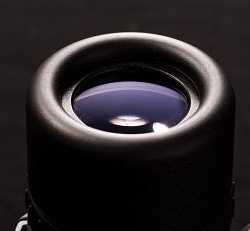 Easier Eye Alignment
Easier Eye Alignment
A larger exit pupil makes it easier to line your pupils up with the shaft of light that is exiting the ocular lens, but as well as a larger exit pupil, a larger ocular also makes this easier and also minimizes the blackout that occurs with improper eye position.
Wider Field of View
According to the guys at Tract Optics, a larger ocular also helps to make it possible to create a eyepiece that produces a wider field of view.
I discovered this whilst reviewing their Tract Toric 8x42 Binoculars that has 24mm ocular lenses which is really large for a 42mm binocular in my experience. They are one of the few companies that advertise this as a feature when marketing their product.
Better Image Resolution
A larger lens makes it possible to produce a higher image resolution for a clearer, more sharp image.
More Eye-Relief?
I’m not so sure about this one, but I have read that larger oculars make it possible to have a longer eye relief?
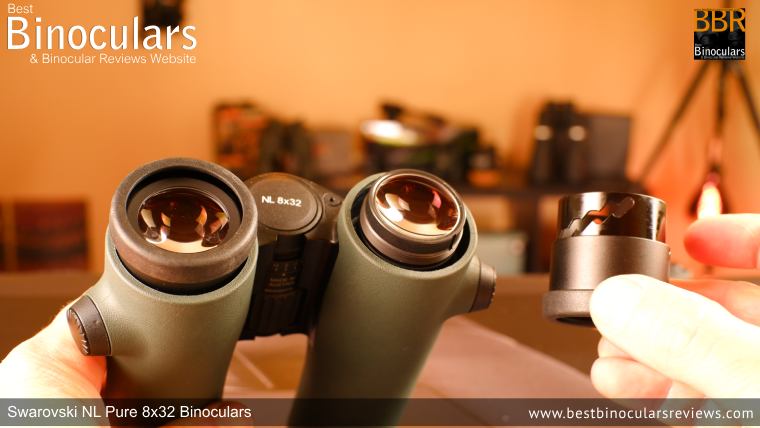
Removable eyecups showing the large 25mm Oculars on the Swarovski NL Pure 8x32 Binoculars
Binoculars with Large Ocular Lenses
Below are some binoculars that I have reviewed with what I have found to have large oculars within their respective size classes:
Fujinon Polaris 7x50 FMTRC-SX Binoculars
Ocular Lens Diameter: 27mm
Eye-Relief: 23mm
Minox BL HD 8x44 Binoculars
Ocular Lens Diameter: 25mm
Eye-Relief: 19.5mm
Maven B1.2 10x42 Binoculars
Ocular Lens Diameter: 25mm
Eye-Relief: 17.8mm
Maven B6 12x50 Binoculars
Ocular Lens Diameter: 25mm
Eye-Relief: 17.5mm
Steiner Nighthunter 8x56 Binoculars
Ocular Lens Diameter: 25mm
Swarovski NL Pure 8x32 Binoculars
Ocular Lens Diameter: 25mm
Eye Relief: 18mm
 GPO Passion HD 10x42 Binoculars
GPO Passion HD 10x42 Binoculars
Ocular Lens Diameter: 24mm
Eye-Relief: 17mm
GPO Passion HD 10x50 Binoculars
Ocular Lens Diameter: 24mm
Eye-Relief: 17mm
Bresser Pirsch ED 8x56 Binoculars
Ocular Lens Diameter: 24mm
Eye-Relief: 19.7mm
Vortex Razor UHD 10x42 Binoculars
Ocular Lens Diameter: 24mm
Eye-Relief: 16.7mm
Opticron Verano BGA HD 8x42 Binoculars
Ocular Lens Diameter: 24mm
Eye-Relief: 22mm
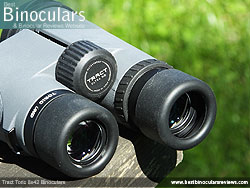 Tract Toric 8x42 Binoculars
Tract Toric 8x42 Binoculars
Ocular Lens Diameter: 24mm
Eye-Relief: 19mm
Maven B2 11x45 Binoculars
Ocular Lens Diameter: 24mm
Eye-Relief: 16.7mm
Opticron Imagic BGA VHD 8x42 Binoculars
Ocular Lens Diameter: 24mm
Eye-Relief: 12mm
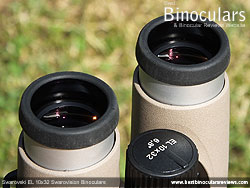 Swarovski EL 10x32 Swarovision Binoculars
Swarovski EL 10x32 Swarovision Binoculars
Ocular Lens Diameter: 24mm
Eye-Relief: 17.3mm
Athlon Argos 8x42 Binoculars
Ocular Lens Diameter: 23mm
Eye-Relief: 17.3mm
As I say, this is just what I have been able to establish through research on the web.
If you have any further information to provide or something that you would just like to add, please either comment in the section below or please feel free to contact me as I for one would love to know more.

 Article | Posted by Best Binocular Reviews
Article | Posted by Best Binocular Reviews 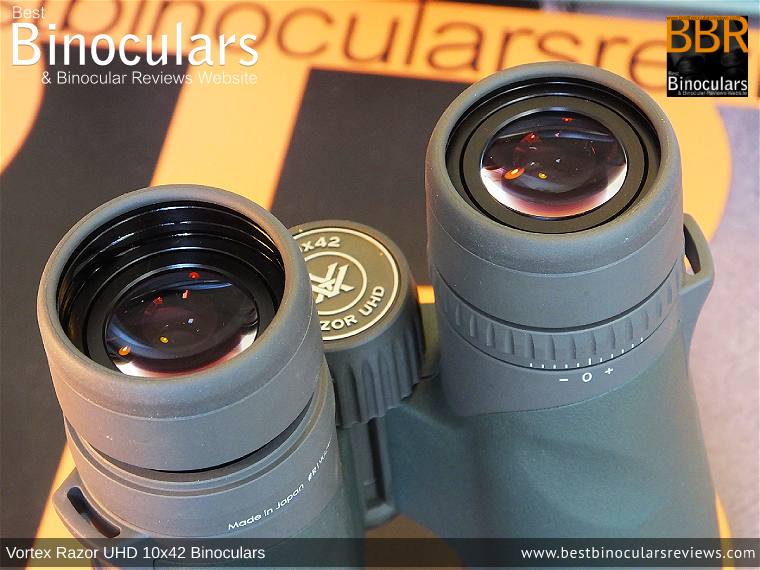
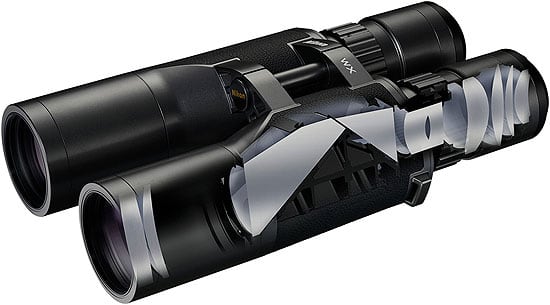

 Categories:
Categories:  Tags:
Tags: 

I have deep narrow eye sockets and large eye pieces narrow my field of view because they keep the lenses too far from my eyes. I’m looking for IS binoculars with smaller diameter eye pieces than Canon 10x42s.
I agree with this. I have several high end binoculars from various manufacturers. I also have some mid tier and low tier I have acquired over time. In bright, good conditions, they can be comparable. The low tier will not have the fine detail resolution, but it can still give satisfying results. This being said, binoculars with the larger diameter ocular lens always seems to be easier to use and more satisfying. I recently purchased two sets of low/mid tier binos from two different companies that are fixed focus to view hawks/ vultures and planes. The ones with the larger ocular lenses are the better of the two. They also have the best eye relief and the better lens coatings (fully coated vs multicoated, 12mm vs 15mm eye relief). Honestly, when I first unbox a pair of binos, this is the feature I notice first for a hint of quality. The second important thing no one mentions is good lens adjustment (eyes closer together vs further apart) that I look for. You would have to be a large man to look through some binos because they will not adjust close together enough. Not sure what some manufacturers/ engineers are thinking here. There are many people that are not large in stature looking through binoculars and this feature would be very inexpensive to incorporate. Good article and good website. Thank you.
For people with deep narrow eye sockets, large diameter ocular lenses increase the distance between eye and lens, severely reducing the field of vision. (Another reason why the info you’ve been gathering is useful.) So I need to find IS binoculars (for my tremor) with small ocular lens diameters. My canon 10 x 42s are great, except for the small field of view resulting from their large diameter (46mm) ocular eyepieces.
Do you know of any IS binoculars that fit the bill?
[…] But what I can say here is the Maven has very large 25mm ocular lenses and whilst I have not measured them, nor can I find any info, I doubt that the Vortex will equal this – Large ocular lenses can provide us with a number of advantages, including improving image resolution and making it easier to line your eyes up to them correctly (so less black rings forming on the edges of the view). For more, take a look at my article on Binocular ocular lens size. […]